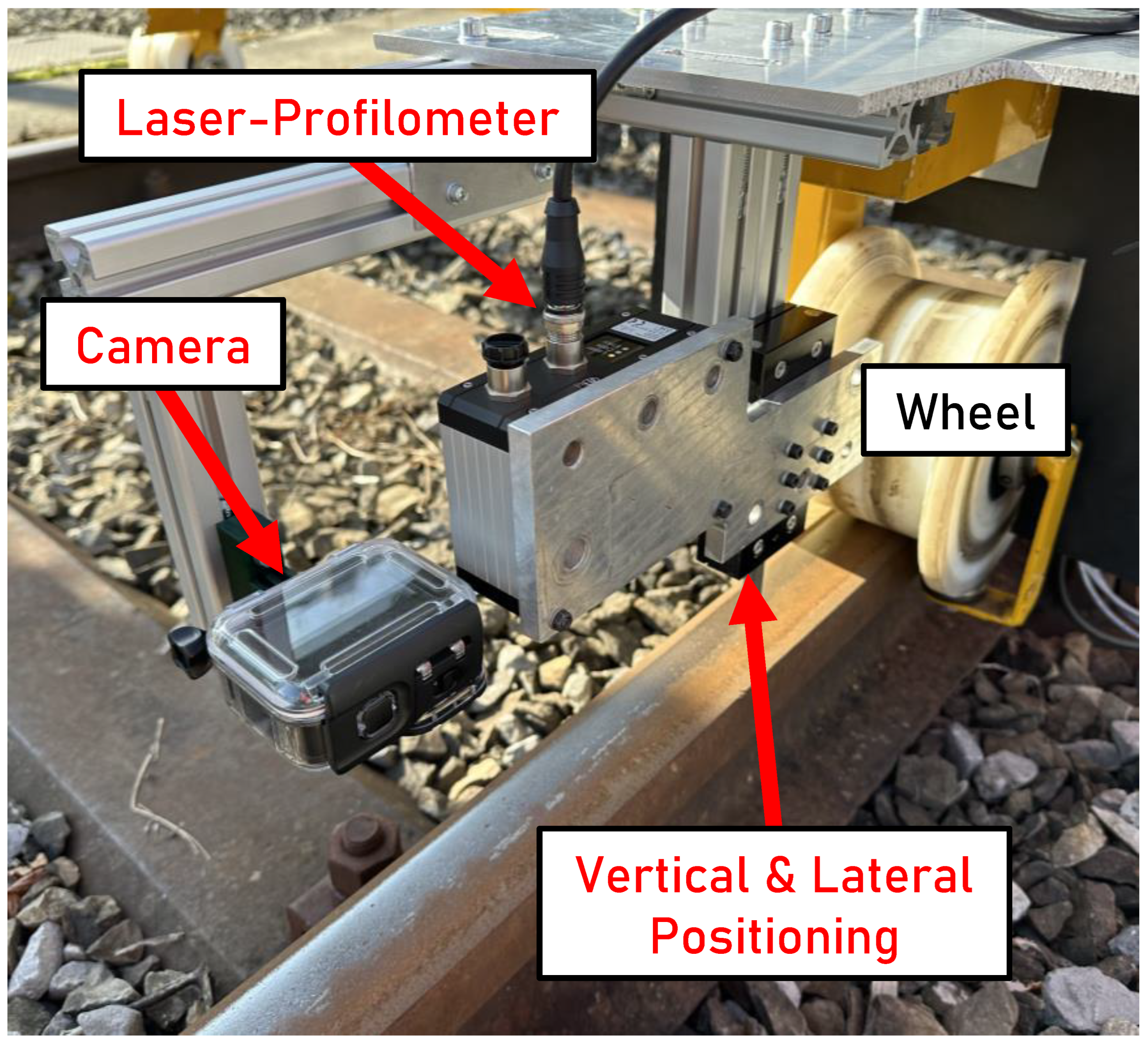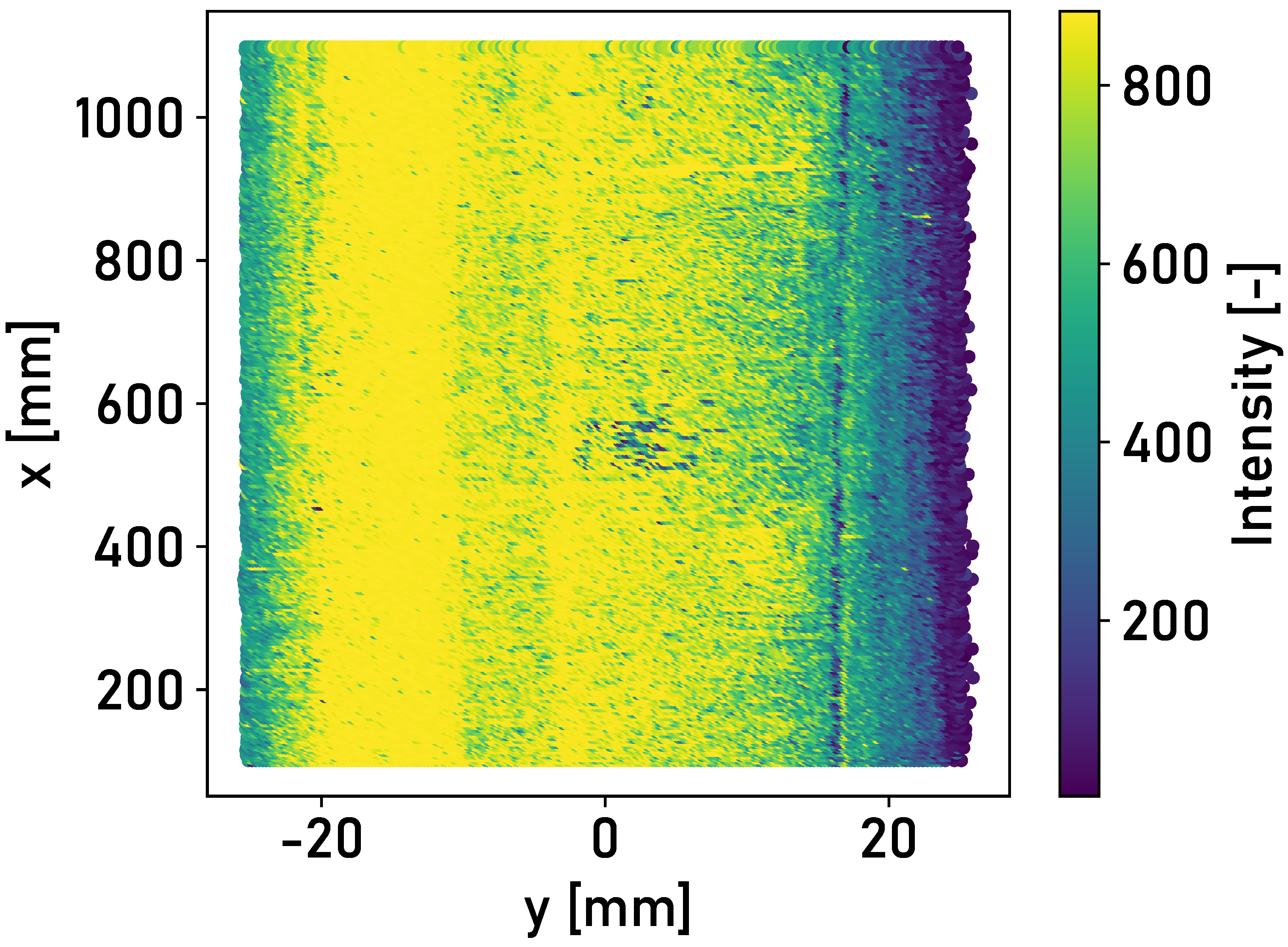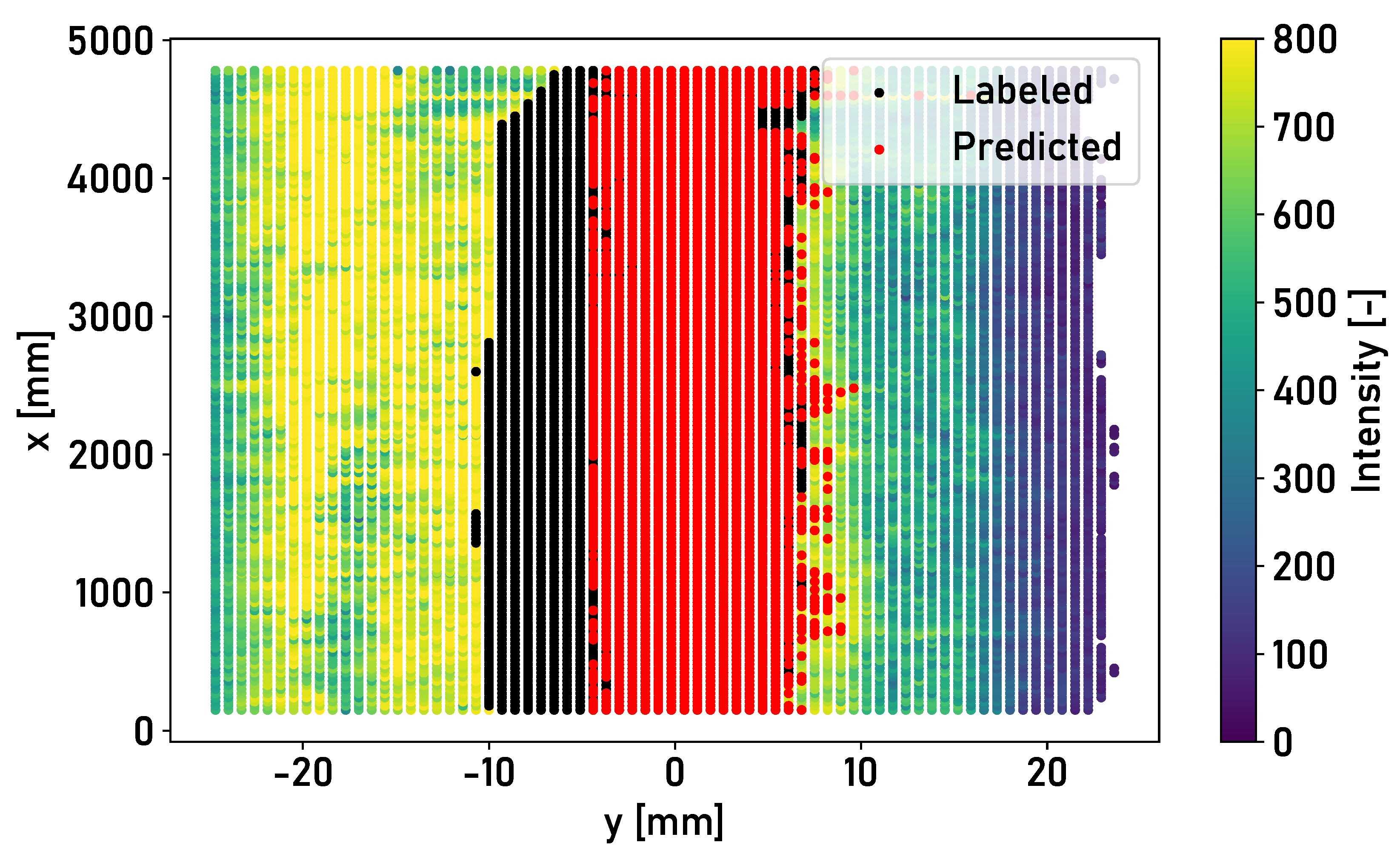Automatic Detection of the Running Surface of Railway Tracks Based on Laser Profilometer Data and Supervised Machine Learning
Abstract
:1. Introduction
2. Materials and Methods
2.1. Experimental Setup
- Central: The lateral position of the laser profilometer is centered towards the middle of the railhead.
- Left: From the central lateral position, the laser profilometer is shifted 10 to the left.
- Right: From the central lateral position, the laser profilometer is shifted 10 to the right.
- Rail 1 is located in front of a depot for rail vehicles and is rarely frequented. Slight corrosion within the running surface is evident.
- Rail 2 is also located in front of a depot for rail vehicles. Compared to Rail 1, Rail 2 is more frequently operated due to the regular operation of vehicles.
- Rail 3 is located on a regularly frequented section of the track. At the time of measurement, the section of road was closed for 3 to 4 days due to construction works. The rail surface is characterized by a wide and established running surface.
2.2. Detection Approach
- Average intensity of the reflected light within a surface element: A high intensity of reflected light corresponds to the area of the running surface.
- Standard deviation of intensity of the reflected light within a surface element: Outside the area of the running surface, a stronger fluctuation in the detected intensity can be observed.
- Lateral position y of a surface element within the reference system of the trolley setup: The running surface is typically located on the inside of the rail and the lateral position is therefore characteristic. This is particularly relevant for rail surfaces with thin corrosion layers and potentially multiple areas of high intensity.
- Measurement of the longitudinal position x along the rail and the lateral position y across the rail, as well as the distances z to the rail surface and the intensity of the light reflected from the surface for each measuring point.
- The measured intensities are grouped into surface elements in the x–y plane. The surface element size is × 50 ( × ). A longitudinal and a lateral position are assigned for each surface element.
- An average intensity as well as a corresponding standard deviation of intensity is determined for each surface element. In combination with the lateral position of the surface element, the mean intensity and the standard deviation serve as features for the classification.
- A pre-trained model is applied to perform the binary classification of the surface elements as “running surface” or “no running surface”.
- The lateral positions of the edges and of the running surface in the reference system of the trolley setup are determined based on the classification of the rail surface elements. If more than 35% of the surface elements at the same lateral position are classified as “running surface”, the entire line along the rail is assigned to the running surface. The threshold value of 35% is determined empirically based on available measurements. The threshold value can be adjusted for a more conservative determination of the running surface.
- Calculation of the width of the running surface.
- The reference systems of the trolley setup and the rail do not coincide. The offset of the reference systems must be determined to obtain the lateral position of the running surface in the reference system of the rail. The laser profilometer detects part of the transverse profile of the rail. The reference profile of the rail is known. The lateral offset can be determined by a curve fit and, consequently, the lateral position of the running surface is known in the reference system of the rail.
3. Results
4. Discussion
5. Conclusions
Author Contributions
Funding
Institutional Review Board Statement
Informed Consent Statement
Data Availability Statement
Conflicts of Interest
References
- Nold, M.; Corman, F. How Will the Railway Look Like in 2050? A Survey of Experts on Technologies, Challenges and Opportunities for the Railway System. IEEE Open J. Intell. Transp. Syst. 2024, 5, 85–102. [Google Scholar] [CrossRef]
- Tanaka, H.; Miwa, M. Modeling the development of rail corrugation to schedule a more economical rail grinding. Proc. Inst. Mech. Eng. Part F J. Rail Rapid Transit 2020, 234, 370–380. [Google Scholar] [CrossRef]
- Zoeteman, A.; Dollevoet, R.; Fischer, R.; Lammers, J.W. 28-Managing the wheel–rail interface: The Dutch experience. In Wheel–Rail Interface Handbook; Lewis, R., Olofsson, U., Eds.; Woodhead Publishing: Sawston, UK, 2009; pp. 792–818. [Google Scholar] [CrossRef]
- Dhillon, B. Engineering Maintenance: A Modern Approach; CRC Press: Boca Raton, FL, USA, 2002. [Google Scholar] [CrossRef]
- Edel, K.O.; Budnitzki, G.; Schnitzer, T. Schienenfehler 1: Beanspruchung und Schädigung von Eisenbahnschienen, 1st ed.; Springer: Berlin/Heidelberg, Germany, 2021. [Google Scholar] [CrossRef]
- Satoh, Y.; Iwafuchi, K. Crystal orientation analysis of running surface of rail damaged by rolling contact. Wear 2005, 258, 1126–1134. [Google Scholar] [CrossRef]
- Wang, Q.; Gao, T.; He, Q.; Liu, Y.; Wu, J.; Wang, P. Severe rail wear detection with rail running band images. Comput.-Aided Civ. Infrastruct. Eng. 2023, 38, 1162–1180. [Google Scholar] [CrossRef]
- Thompson, D. On the relationship between wheel and rail surface roughness and rolling noise. J. Sound Vib. 1996, 193, 149–160. [Google Scholar] [CrossRef]
- Kuffa, M.; Ziegler, D.; Peter, T.; Kuster, F.; Wegener, K. A new grinding strategy to improve the acoustic properties of railway tracks. Proc. Inst. Mech. Eng. Part F J. Rail Rapid Transit 2018, 232, 214–221. [Google Scholar] [CrossRef]
- Cordier, J.F.; Fodiman, P. Experimental characterization of wheel and rail surface roughness. J. Sound Vib. 2000, 231, 667–672. [Google Scholar] [CrossRef]
- Grassie, S.; Saxon, M.; Smith, J. Measurement of longitudinal rail irregularities and criteria for acceptable grinding. J. Sound Vib. 1999, 227, 949–964. [Google Scholar] [CrossRef]
- DIN EN 13231-2:2020; Bahnanwendungen. Oberbau. Abnahme von Arbeiten. Teil 2: Abnahme von Reprofilierten Schienen im Gleis, Weichen, Kreuzungen und Schienenauszügen. Deutsche Fassung. Beuth: Berlin, Germany, 2020. [CrossRef]
- Chen, L.; Li, Y.; Ma, Z.; Liu, H.; Mao, W. Vision-Based Position Deviation Measurement of Rail Corrugation Chord Measuring Points Under Bi-Linear Laser Assistance. IEEE Access 2021, 9, 36207–36217. [Google Scholar] [CrossRef]
- DIN EN 15610:2019; Bahnanwendungen. Akustik. Messung der Schienen- und Radrauheit im Hinblick auf die Entstehung von Rollgeräuschen. Deutsche Fassung. Beuth: Berlin, Germany, 2021. [CrossRef]
- Mauz, F.; Wigger, R.; Wahl, T.; Kuffa, M.; Wegener, K. Acoustic Roughness Measurement of Railway Tracks: Implementation of a Chord-Based Optical Measurement System on a Train. Appl. Sci. 2022, 12, 11988. [Google Scholar] [CrossRef]
- Ye, J.; Stewart, E.; Roberts, C. Use of a 3D model to improve the performance of laser-based railway track inspection. Proc. Inst. Mech. Eng. Part F J. Rail Rapid Transit 2019, 233, 337–355. [Google Scholar] [CrossRef]
- Mauz, F.; Wigger, R.; Griesbaum, L.; Wahl, T.; Kuffa, M.; Wegener, K. Acoustic Roughness Measurement of Railway Tracks: Running Surface Detection and Compensation of Lateral Movements for Optical Measurements on a Train. Sensors 2023, 23, 5764. [Google Scholar] [CrossRef] [PubMed]











| Random Forest [%] | K-Neighbors [%] | Linear Support Vector Machine [%] | ||
|---|---|---|---|---|
| Left | 90.00 | 88.00 | 86.00 | |
| Rail 2 | Central | 74.00 | 76.00 | 79.00 |
| Right | 77.00 | 77.00 | 76.00 | |
| Left | 88.00 | 89.00 | 94.00 | |
| Rail 3 | Central | 87.00 | 87.00 | 90.00 |
| Right | 87.00 | 87.00 | 92.00 |
| Longitudinal | Relative Error | ||||||
|---|---|---|---|---|---|---|---|
| Position | [mm] | [mm] | [mm] | [mm] | [mm] | [mm] | |
| Rail 2 | −0.15 | 16.85 | 17 | 16.5 | 0.5 | 3.03% | |
| −2.45 | 16.05 | 18.5 | 16.5 | 2 | 12.12% | ||
| 0.26 | 16.76 | 16.5 | 16 | 0.5 | 3.13% | ||
| −0.15 | 16.35 | 16.5 | 16.5 | 0 | 0.00% | ||
| 1.35 | 17.85 | 16.5 | 17 | −0.5 | −2.94% | ||
| Rail 3 | −20.50 | 17.50 | 38 | 33 | 5 | 15.15% | |
| −20.50 | 17.50 | 38 | 32.5 | 5.5 | 16.92% | ||
| −20.50 | 18.00 | 38.5 | 32.5 | 6 | 18.46% | ||
| −20.50 | 17.00 | 37.5 | 31.5 | 6 | 19.05% | ||
| −19.50 | 17.00 | 36.5 | 31 | 5.5 | 17.74% |
| Rail 2 | Rail 3 | ||||
|---|---|---|---|---|---|
| Average | St. Dev. | Average | St. Dev. | ||
| Left | 2.60 | 1.11 | 2.60 | 1.36 | |
| Relative Error | 16.16 | 6.78 | 9.06 | 4.73 | |
| Central | 0.50 | 0.84 | 5.60 | 0.37 | |
| Relative Error | 3.07 | 5.05 | 17.47 | 1.36 | |
| Right | 0.40 | 1.74 | −1.20 | 4.95 | |
| Relative Error | 1.98 | 12.38 | −3.01 | 12.54 | |
Disclaimer/Publisher’s Note: The statements, opinions and data contained in all publications are solely those of the individual author(s) and contributor(s) and not of MDPI and/or the editor(s). MDPI and/or the editor(s) disclaim responsibility for any injury to people or property resulting from any ideas, methods, instructions or products referred to in the content. |
© 2024 by the authors. Licensee MDPI, Basel, Switzerland. This article is an open access article distributed under the terms and conditions of the Creative Commons Attribution (CC BY) license (https://creativecommons.org/licenses/by/4.0/).
Share and Cite
Mauz, F.; Wigger, R.; Gota, A.-E.; Kuffa, M. Automatic Detection of the Running Surface of Railway Tracks Based on Laser Profilometer Data and Supervised Machine Learning. Sensors 2024, 24, 2638. https://doi.org/10.3390/s24082638
Mauz F, Wigger R, Gota A-E, Kuffa M. Automatic Detection of the Running Surface of Railway Tracks Based on Laser Profilometer Data and Supervised Machine Learning. Sensors. 2024; 24(8):2638. https://doi.org/10.3390/s24082638
Chicago/Turabian StyleMauz, Florian, Remo Wigger, Alexandru-Elisiu Gota, and Michal Kuffa. 2024. "Automatic Detection of the Running Surface of Railway Tracks Based on Laser Profilometer Data and Supervised Machine Learning" Sensors 24, no. 8: 2638. https://doi.org/10.3390/s24082638





